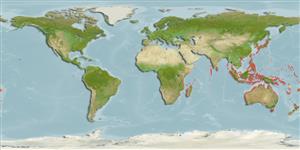Bivalvia |
Galeommatida |
Galeommatidae
Environment: milieu / climate zone / गहराई सीमा / distribution range
पारिस्थितिकी
; गहराई सीमा 0 - 1 m (संदर्भ 8218). Tropical
Indo- Pacific: Australia, Philippines, Rodriguez and Thailand. Subtropical.
Length at first maturity / आकार / Weight / Age
परिपक्व अवधि: Lm ? range ? - ? cm Max length : 1.1 cm SHL पुल्लिंग / अलिंग; (संदर्भ 8218)
Life cycle and mating behavior
परिपक्व अवधि | पुनरुत्पत्ति | मछलीऔ का अंडे देना | Eggs | Fecundity | Larvae
Members of the class Bivalvia are mostly gonochoric, some are protandric hermaphrodites. Life cycle: Embryos develop into free-swimming trocophore larvae, succeeded by the bivalve veliger, resembling a miniature clam.
Lützen, J. and C. Nielsen 2005 Galeommatid bivalves from Phuket, Thailand. Zoological Journal of the Linnean Society 144:261-308. (संदर्भ 3158)
IUCN Red List Status
(संदर्भ 130435: Version 2025-1)
CITES status (संदर्भ 108899)
Not Evaluated
CMS (संदर्भ 116361)
Not Evaluated
Threat to humans
Human uses
| FishSource |
साधन
अधिक जानकारी
Trophic EcologyFood items (preys)
संघटक आहार
आहार खपत
परभक्षी
Population dynamicsबाढ़Max. ages / sizesLength-weight rel.Length-length rel.Length-frequenciesMass conversionबहुतायत Life cycleपुनरुत्पत्तिपरिपक्व अवधिFecundityमछलीऔ का अंडे देनाEggsEgg developmentLarvae PhysiologyOxygen consumption
Human RelatedStamps, coins, misc.
इंटरनेट स्रोत
Estimates based on models
Preferred temperature
(Ref.
115969): 24.6 - 29.3, mean 28.6 (based on 2091 cells).
Fishing Vulnerability
Low vulnerability (10 of 100).
